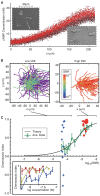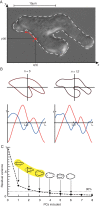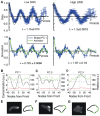Distinct cell shapes determine accurate chemotaxis
- PMID: 24008441
- PMCID: PMC3764443
- DOI: 10.1038/srep02606
Distinct cell shapes determine accurate chemotaxis
Abstract
The behaviour of an organism often reflects a strategy for coping with its environment. Such behaviour in higher organisms can often be reduced to a few stereotyped modes of movement due to physiological limitations, but finding such modes in amoeboid cells is more difficult as they lack these constraints. Here, we examine cell shape and movement in starved Dictyostelium amoebae during migration toward a chemoattractant in a microfluidic chamber. We show that the incredible variety in amoeboid shape across a population can be reduced to a few modes of variation. Interestingly, cells use distinct modes depending on the applied chemical gradient, with specific cell shapes associated with shallow, difficult-to-sense gradients. Modelling and drug treatment reveals that these behaviours are intrinsically linked with accurate sensing at the physical limit. Since similar behaviours are observed in a diverse range of cell types, we propose that cell shape and behaviour are conserved traits.
Figures






Similar articles
-
Tools for analyzing cell shape changes during chemotaxis.Integr Biol (Camb). 2010 Nov;2(11-12):561-7. doi: 10.1039/c0ib00036a. Epub 2010 Oct 1. Integr Biol (Camb). 2010. PMID: 20886151 Free PMC article. Review.
-
High fidelity information processing in folic acid chemotaxis of Dictyostelium amoebae.J R Soc Interface. 2013 Sep 11;10(88):20130606. doi: 10.1098/rsif.2013.0606. Print 2013 Nov 6. J R Soc Interface. 2013. PMID: 24026470 Free PMC article.
-
Directional sensing of deformed cells under faint gradients.Phys Rev E Stat Nonlin Soft Matter Phys. 2012 Dec;86(6 Pt 1):060901. doi: 10.1103/PhysRevE.86.060901. Epub 2012 Dec 14. Phys Rev E Stat Nonlin Soft Matter Phys. 2012. PMID: 23367886
-
Persistent pseudopod splitting is an effective chemotaxis strategy in shallow gradients.Proc Natl Acad Sci U S A. 2025 May 13;122(19):e2502368122. doi: 10.1073/pnas.2502368122. Epub 2025 May 8. Proc Natl Acad Sci U S A. 2025. PMID: 40339116 Free PMC article.
-
Signaling pathways at the leading edge of chemotaxing cells.J Muscle Res Cell Motil. 2002;23(7-8):773-9. doi: 10.1023/a:1024479728970. J Muscle Res Cell Motil. 2002. PMID: 12952075 Review.
Cited by
-
T cell morphodynamics reveal periodic shape oscillations in three-dimensional migration.J R Soc Interface. 2022 May;19(190):20220081. doi: 10.1098/rsif.2022.0081. Epub 2022 May 11. J R Soc Interface. 2022. PMID: 35537475 Free PMC article.
-
Memory improves precision of cell sensing in fluctuating environments.Sci Rep. 2014 Jul 14;4:5688. doi: 10.1038/srep05688. Sci Rep. 2014. PMID: 25023459 Free PMC article.
-
Physics-informed deep learning characterizes morphodynamics of Asian soybean rust disease.Nat Commun. 2021 Nov 5;12(1):6424. doi: 10.1038/s41467-021-26577-1. Nat Commun. 2021. PMID: 34741028 Free PMC article.
-
Coupled excitable Ras and F-actin activation mediates spontaneous pseudopod formation and directed cell movement.Mol Biol Cell. 2017 Apr 1;28(7):922-934. doi: 10.1091/mbc.E16-10-0733. Epub 2017 Feb 1. Mol Biol Cell. 2017. PMID: 28148648 Free PMC article.
-
Crawling, waving, inch worming, dilating, and pivoting mechanics of migrating cells: Lessons from Ken Jacobson.Biophys J. 2023 Sep 19;122(18):3551-3559. doi: 10.1016/j.bpj.2023.03.023. Epub 2023 Mar 17. Biophys J. 2023. PMID: 36934300 Free PMC article. Review.
References
-
- Hicheur H., Pham Q. C., Arechavaleta G., Laumond J. P. & Berthoz A. The formation of trajectories during goal-oriented locomotion in humans. I. A stereotyped behaviour. Eur. J. Neurosci. 26, 2376–2390 (2007). - PubMed
-
- Csermely D., Bonati B. & Romani R. Predatory behaviour of common kestrels (falco tinnunculus) in the wild. J. Ethol. 27, 461–465 (2009).
Publication types
MeSH terms
Grants and funding
LinkOut - more resources
Full Text Sources
Other Literature Sources

